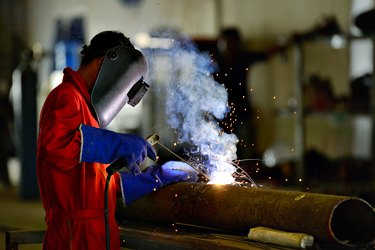Do you have a welder sitting in your garage just waiting to get fired up? If you're eager to get going on some yard art or fabrication work on the hot rod that's been parked in the third stall for 10 years, you might be wondering what types of welds are best to use. Depending on what you're working on, you will choose a weld based on the different strength properties and the purpose. Two types of welds that work for many non-commercial environments are spot and seam welds.
The welds from both spot and seam welds happen when pressure is applied to two overlapping sheets being joined. An electrical current is applied, which causes resistive heating. This forces the metal to melt and a weld is formed. Although both are considered electric resistance welding techniques, there are some differences between the two.
Video of the Day
Video of the Day

What is Spot Welding?
If you need to join two pieces of metal together, spot welding will get the job done quick. It's often used to teach people how to weld, so the process is less complicated than other types of welding.
Spot welding uses two copper alloy electrodes to concentrate welding currents into a small area, which creates welds at regular intervals on overlapping pieces of metal. When spot welding, you typically use sheets of metal with a thickness of 0.5 to 3 millimeters. The type of material most commonly used includes sheet metal, welded wire mesh and wire mesh.
Spot welding does not require shielding gas in order to complete the weld. You can use a specially designed spot welder to create these types of welds or use an MIG welder with a spot welding kit.
You will need to pay attention to the amount of pressure you apply to the welds. If you don't apply enough pressure, the welds will be small and weak. But if you apply too much, you risk cracking the weld.
Spot welding takes a lot of practice to master, but once you do it's the quickest and easiest way to get many of your home projects done. Also, don't expect the weld to be iron-clad. Since it can only create localized joints, spot welds may lack the strength needed for larger projects.
Pros and Cons of Spot Welding
Pros: Spot welding is the most common form of resistance welding and is best known for its speed and ability to produce a lot of welds in a short amount of time. No filler metal is needed, it is energy efficient and it is also relatively easy to learn.
Cons: Spot welding cannot be used for thicker metal and the welds can be weak. Plus, they are not very attractive looking. Additionally, spot welders can be more expensive than other welders.
What is Seam Welding?
A seam weld is a continuous weld along a joint. Because the joint is forged due to the heat and pressure applied, a seam weld produces a very sturdy weld.
The fillet weld and butt joint weld are the two common types of seam welds. A fillet weld is a triangular seam weld that joins two surfaces at right angles to each other and butt welds are generally in a lap joint, T-joint or corner joint.
Unlike a spot weld that uses a single point electrode, a seam weld uses a rotating wheel electrode that produces a rolling resistance weld. This process is most often used to join two sheets of metal. MIG and TIG welders can be used to do seam welding.
If you need to cover a larger surface area with a stronger weld, you might want to consider using a seam weld. This process can be used to join two sheets of metal together and is ideal if you need a continuous, leak-tight joint.
Pros and Cons of Seam Welding
Pros: Seam welding produces gas-tight and liquid-tight joints, which are needed when welding things like fuel tanks. It also produces less overlap than spot welds.
Cons: Seam welding is restricted to a straight line or uniformly curved line. And a relatively higher current is required for seam welding than spot welding.
How You Can Use Spot and Seam Welding at Home
Once you get comfortable with your welding machine and a few different techniques, you'll be ready to tackle some home and garage projects.
Since spot welding is used to weld smaller sheet metal parts that are overlapping, it's a good choice for things like automotive assembly, automotive restoration, HVAC, brackets, cabinets and other sheet metal projects.
Seam welding is most commonly used for projects that require a leak-tight weld or long strings of spot welds. That's why it's a good choice for things like boxes, cones, cylinders or any project that needs a continuous weld.